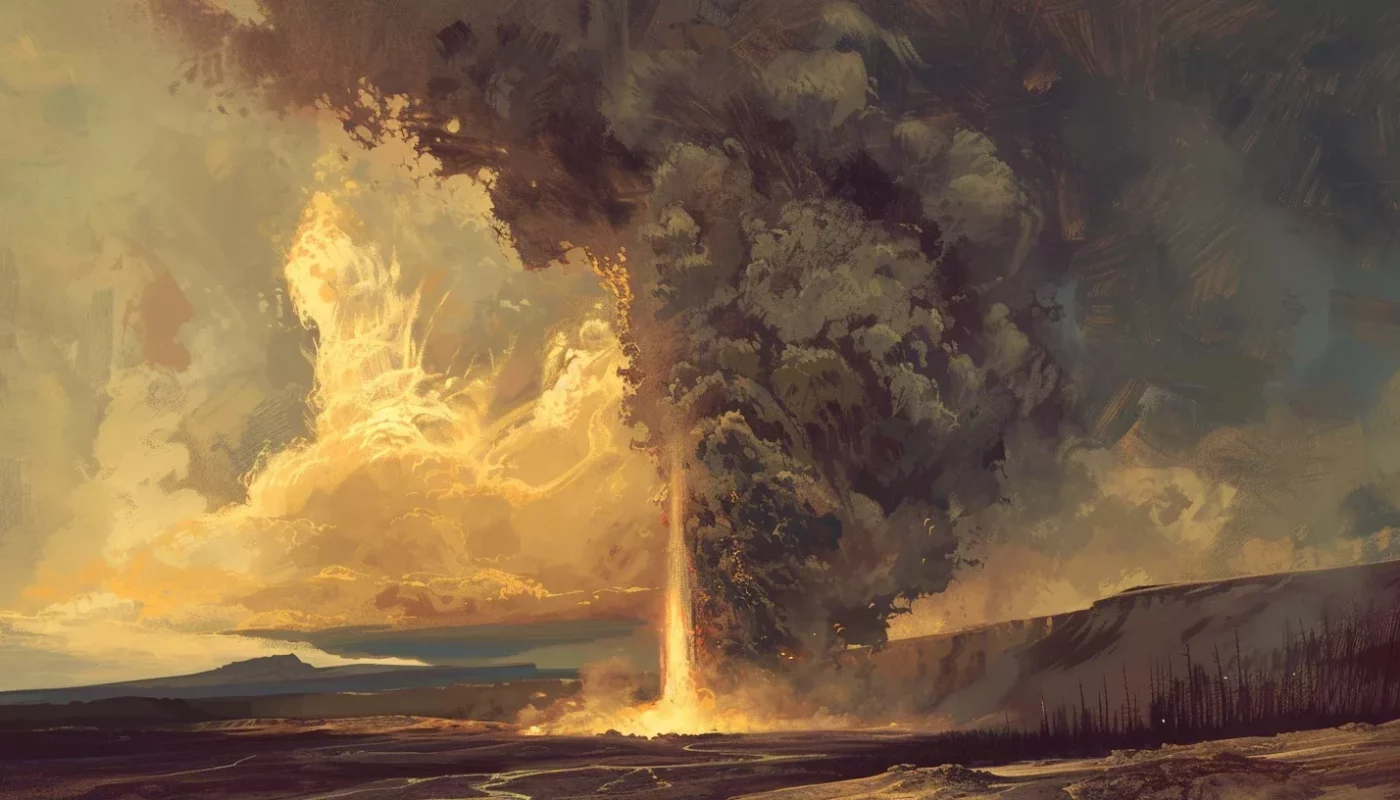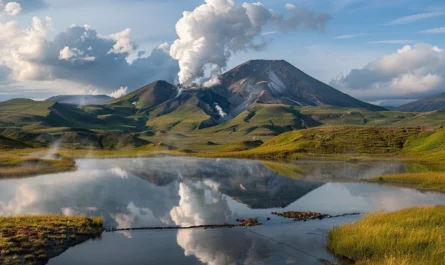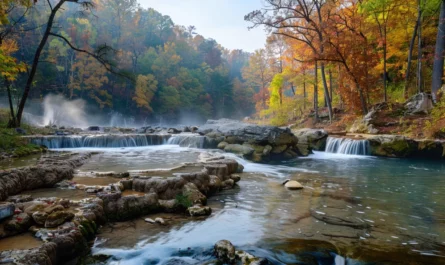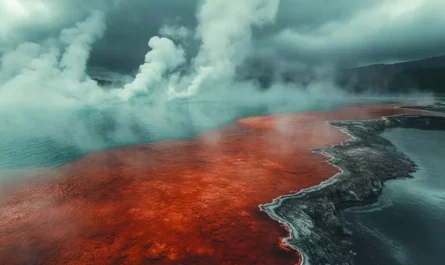Old Faithful Geyser is in Yellowstone’s Upper Geyser Basin. It is known for its timely eruptions, thanks to nature’s clockwork. The 1870 Washburn Expedition named it for its regular spurts since then. Although not the biggest or most punctual geyser in Yellowstone, it erupts more often than any other large geyser.
An eruption can last from 1.5 to 5 minutes and can shoot water up to 184 feet high. Eruptions happen every 35 to 120 minutes, on average every 92 minutes. Predictions about when it will erupt are right about 90 percent of the time, give or take 10 minutes.
Experts believe the time between eruptions has gotten longer for a few reasons. These include changes in groundwater and the paths it takes underground.
The Best Guess
Old Faithful Geyser is a geyser in Yellowstone National Park with predictable eruptions. The predictions are made by looking at the last eruption’s height and how long it lasted. Park naturalists keep these stats up-to-date by watching and timing each blast.
Old Faithful erupts about 20 times daily, with breaks of 60 to 110 minutes. On average, it erupts every 74 minutes. This timing can change based on the last eruption. The predictions are about 90% accurate, with a 10-minute possible difference.
Eruption Prediction Methodology
Predicting Old Faithful’s blasts is based on careful observations. By tracking each eruption’s length and height, naturalists find patterns. This data helps them guess when the next eruption will happen.
The previous eruption’s duration and height are key to guessing the time till the next one. A short, low eruption means a quicker next eruption. However, a long, tall eruption suggests a longer wait time.
Predicting Accuracy
The accuracy of predicting Old Faithful is impressively high. With a 90% success rate, visitors can plan their visit accurately. Despite some variations, these eruptions can be predicted very accurately.
At Yellowstone, visitors can see Old Faithful and be amazed. They know its eruptions are predicted with science and careful watching.
Old Faithful’s Interval
The Old Faithful Geyser eruption interval has changed over time. Before the 1959 Hebgen Lake earthquake, eruptions happened more often. After the earthquake, the time between eruptions got longer. Each earthquake since then has made this interval even longer.
Today, Old Faithful eruptions happen about every 74 minutes. But, they can range from 60 to 110 minutes. This timing varies and depends on the length of the last eruption.
Longer eruptions usually mean longer waits until the next one. Shorter ones lead to shorter waits. This shows the geyser’s inner workings are complexly linked to its eruption timing.
Impact of Earthquakes
Earthquakes greatly affect Old Faithful’s eruption schedule. The major quake in 1959, measuring 7.3, changed its activity pattern. It made the wait times between eruptions longer.
After that quake in 1959, the average eruption interval went from 65 to about 90 minutes. The earthquake affected the underground water paths and pressure.
Scientists are still figuring out how earthquakes change geyser eruption times. But it’s clear that these events have a big impact on geothermal features like Old Faithful.
The picture above captures Old Faithful’s powerful eruption. It’s a sight that amazes visitors and motivates scientists. They want to learn more about what powers such geothermal wonders at Yellowstone National Park.
Height and Duration of Eruptions
The iconic Old Faithful Geyser in Yellowstone National Park puts on a show that keeps people from all over the world coming back. It shoots up water between 100 to 180 feet high. The average height is usually around 130-140 feet, leaving everyone amazed.
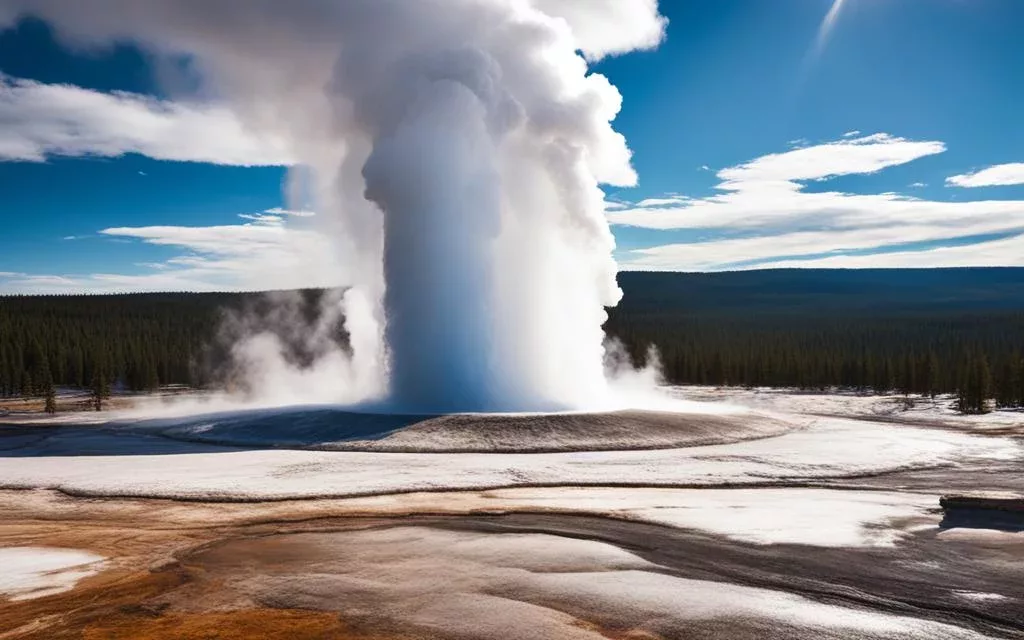
The eruptions at Old Faithful last from 1.5 to 5 minutes. This stunning event highlights the natural beauty of Yellowstone. Boiling water shoots up, captivating all who see it.
During an eruption, Old Faithful pushes out 3,700 to 8,400 gallons of boiling water. This shows the incredible energy from beneath Earth’s crust. The eruptions often reach about 145 feet high, showing the geyser’s powerful force.
The Height and Duration of Old Faithful’s Eruptions
| Eruption Height (feet) | Eruption Duration (minutes) |
|---|---|
| 100 | 1.5 |
| 120 | 2.5 |
| 140 | 3.5 |
| 160 | 4.5 |
| 180 | 5 |
Seeing these incredible eruptions fills onlookers with awe. It shows the amazing and unpredictable power of nature in an unforgettable way.
Factors Affecting Eruption Interval
The time between Old Faithful’s eruptions is changed by many things. These make the geyser’s actions interesting to study.
Underground Channels
Certain scientists think underground tunnels affect Old Faithful’s eruption times. These tunnels carry water and steam from deep in the Earth to the geyser. Over time, these tunnels might change shape or size.
This can change how water and steam move, shifting eruption schedules.
Earthquakes
Earthquakes, like the big one in 1959 at Hebgen Lake, influence Old Faithful’s eruptions. These shakes can mess with the ground around the geyser, possibly changing how water and steam flow underneath. So, earthquakes can make eruption times vary.
Changes in Groundwater
Building things like parking lots near Old Faithful has sparked worry about the local water underground. Some experts believe these human activities have made the geyser erupt less often. If the amount and path of water underground change, it can affect the eruptions.
“Old Faithful’s eruptions can be altered by tunnel changes, quakes, and groundwater shifts.”
Eruptions have become more predictable despite these factors. Scientists watch these elements closely. They do this to better understand and predict Old Faithful’s show for all who visit Yellowstone National Park.
Water Temperature and Steam
Old Faithful Geyser’s eruptions are a stunning show of nature’s strength. It shoots up lots of water and steam. The water hits 204°F at the vent, while the steam goes beyond 350°F. This is caused by the heat from below the ground.
The geyser’s water gets heated deep inside Earth, then blasts high into the sky. This amazing sight can shoot water up to 180 feet high. On average, Old Faithful’s eruptions reach about 130-140 feet.
The erupting water is extremely hot and full of minerals. These minerals add to the colorful and unique features around the geyser.
Seeing Old Faithful erupt shows nature’s incredible force and beauty. The mix of high water jets and steam is memorable for visitors worldwide.
Staying Safe Around Old Faithful
Old Faithful’s eruptions are amazing but require caution. The hot water and steam are very dangerous. Everyone should stay on the marked paths for safety.
Stepping off the paths can hurt you and the park’s nature. Yellowstone has rules to keep its features safe, like Old Faithful. Following them helps protect this wonder for the future.
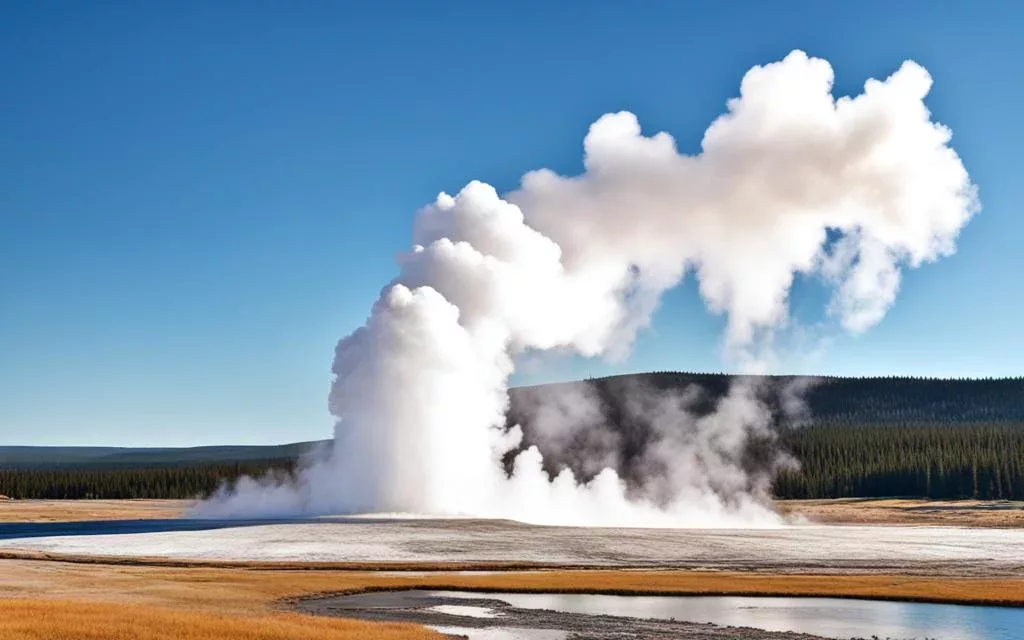
Water Volume Released During Eruptions
An eruption of Old Faithful is not just a sight. It also sends a lot of water into the air. The amount changes with how long the eruption lasts.
| Eruption Duration | Estimated Water Volume |
|---|---|
| 1.5 minutes | 3,700 gallons |
| 4.5 minutes | 8,400 gallons |
This shows Old Faithful’s immense power. As it erupts, it sends a beautiful mix of water, steam, and minerals into the air. This spectacle draws people back time after time.
Avoiding Crowds at Old Faithful
Old Faithful Geyser is a top spot at Yellowstone National Park, attracting many visitors. Yet, for less crowded moments near the geyser, it’s smart to plan well. Avoiding busy times is key.
Afternoons, especially from noon to 6 p.m., bring the most people. This is when tour buses and big groups show up. It can be hard to find a good place to stand and watch.
Looking for a calmer visit? Try going during the less busy seasons or in winter. Fewer visitors mean a quieter setting. This lets you get closer to nature and see Old Faithful’s eruptions more personally.
Winter transforms Yellowstone, with snow adding beauty. This season also has fewer visitors, offering a more private time.
Yet, winter visits need more planning. Always check for any road closures. Also, bring the right winter clothes to keep warm and safe.
Conservation Efforts
Yellowstone National Park focuses heavily on preserving its geothermal wonders, including Old Faithful Geyser. This famous attraction highlights the need to balance exploration with the protection of Yellowstone’s natural treasures.
When near geothermal features like Old Faithful, visitors must stick to the paths and boardwalks. These paths keep people safe and reduce damage to the surrounding ecosystems. Following these rules helps protect these natural sites for the future.
“Yellowstone’s geothermal wonders offer a rare experience, but we must care for them. We’re just guests here, and our choices matter. By using the marked paths, we can safeguard the ecosystems around the geysers and ensure they last.”
Yellowstone also focuses on educating visitors about geothermal conservation. It’s working to spread the word on the importance of keeping these sites intact. Efforts include educational programs and actions raising awareness among visitors.
With signs, tours, and displays, guests learn why these features matter and how they’re protected. These educational efforts build conservation awareness. They encourage people to value and conserve these natural wonders.
Conservation Programs and Initiatives
Yellowstone teams up with groups to create conservation plans for its geothermal sites. These initiatives tackle the challenge of protecting geysers and hot springs. They’re designed to protect these unique natural features.
The park focuses on scientific research and sustainable practices to lessen visitor impact. Scientists, rangers, and conservationists work together for effective conservation. Their combined efforts ensure a thoughtful approach to protecting these wonders.
“Conservation takes teamwork. We count on everyone – visitors, staff, and partners – to help. Together, we’ll keep Yellowstone’s amazing geothermal features safe for all to see and enjoy in the future.”
Yellowstone sets an example in balancing exploration and conservation successfully. Through mindful visiting habits and educational efforts, the park ensures its geothermal treasures remain fascinating for everyone. This responsible approach guarantees these wonders continue to amaze visitors responsibly and sustainably.
Other Geysers in Yellowstone
Old Faithful might be the most famous geyser in Yellowstone National Park. However, it’s not the only one worth seeing. The park is full of other incredible geysers, each with its unique features and eruption schedules.
Castle Geyser is amazing, shooting water up to 90 feet high. It erupts every 10 to 12 hours. This makes it a fantastic sight for anyone visiting the park.
Daisy Geyser is known for its punctual eruptions. Every 90 minutes, it sends up a beautiful water column up to 75 feet. It’s a favorite because it’s so reliable.
Grand Geyser draws crowds with its high eruptions. As the world’s tallest predictable geyser, it shoots water 150 to 200 feet high. It erupts every 7 to 15 hours.
Then there’s Riverside Geyser, with its scenic setting by the Firehole River. It shoots water around 75 feet high every 6 to 7.5 hours. It’s a peaceful sight, set against the river flow.
The Great Fountain Geyser is known for powerful eruptions. It goes off every 9 to 15 hours, reaching heights of 75 to 220 feet. Its eruptions can last around 45 minutes.
Together with Old Faithful, these geysers are part of Yellowstone’s amazing geothermal wonders. Each offers a special experience. They show the stunning power and beauty of nature.
| Geyser | Eruption Height | Eruption Frequency | Eruption Duration |
|---|---|---|---|
| Castle Geyser | Up to 90 feet | Every 10-12 hours | N/A |
| Daisy Geyser | Up to 75 feet | Every 90 minutes | N/A |
| Grand Geyser | 150-200 feet | Every 7-15 hours | N/A |
| Riverside Geyser | Up to 75 feet | Every 6-7.5 hours | N/A |
| Great Fountain Geyser | 75-220 feet | Every 9-15 hours | Approximately 45 minutes |
Conservation Efforts
These geysers are not just beautiful. They’re also important for ecology. Yellowstone has started many projects to keep them safe.
Visitors must stay on the paths and boardwalks to avoid harming these areas. The ground around the geysers is very delicate. Walking off the path can damage it.
There are also educational programs to teach visitors about these wonders. These programs help people learn how to enjoy the geysers without hurting them. They ensure these sights remain for the next generations.
Conclusion
Old Faithful Geyser in Yellowstone National Park continues to amaze its visitors. It erupts in a breathtaking way that you can predict. Even though it takes longer between each eruption, it shows how timely nature can be.
Its eruptions have been watched for many years. This lets people from all generations see this amazing geothermal wonder. Future visitors will also get to enjoy and learn from Old Faithful.
Keeping Old Faithful safe is very important. We need to protect and look after Yellowstone’s special thermal features. Visitors should stay on the paths and boardwalks. This helps protect the natural area around the geyser.
By learning and spreading awareness, we can keep Old Faithful beautiful. This way, its breathtaking view can be enjoyed now and in the future. Everyone has a role in protecting this wonder.
Thinking of visiting Yellowstone National Park? Don’t miss seeing Old Faithful Geyser erupt. You’ll be amazed by the strength of the earth’s heat. And you’ll love the natural beauty of this famous place.

